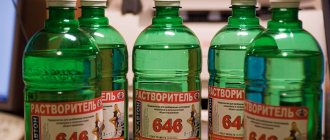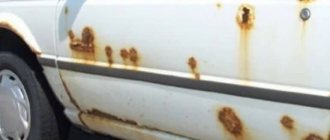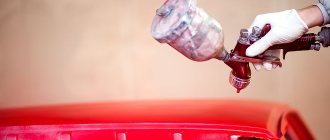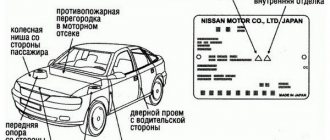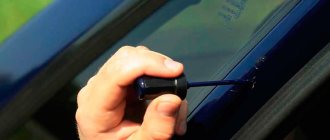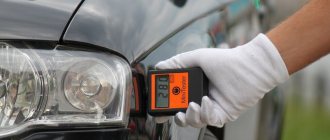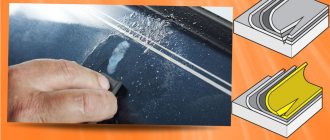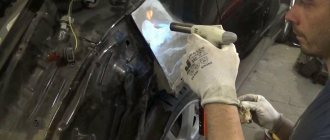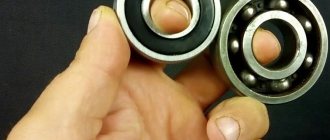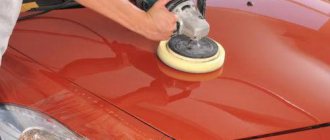Prolonged contact of solvent-based resinous materials used in road construction with the paintwork of a vehicle can cause local defects. If you find tar or bitumen on the body, it should be washed off the car without damaging the paintwork . It is better to take measures immediately, not allowing contaminants to penetrate deep into the varnish; in this case, you can use both special means and safe universal solvents.
In this article we will tell you how and how to wash tar from a car without consequences and present a rating of special products for removing bitumen from the body.
What should not be used to remove tar from a car body
First, let’s look at what should not be used to remove bitumen stains. Listed below are substances that are ineffective as bitumen cleaners and/or can damage paint and metal.
See the table for what not to clean tar from your car.
| Should not be used | Why |
| Acids | Together with dirt, paintwork also corrodes and can cause corrosion, but the resins are not very effectively dissolved. |
| Acetone | Ineffective due to rapid evaporation, but may begin to corrode the varnish. |
| Gasoline (motor) | In its pure form it is safe for paintwork, but the additives contained in gasoline can be more aggressive. It evaporates quickly and does not have time to properly dissolve the pollution. |
| Solvent | Capable of dissolving bitumen and tar, but aggressive towards paintwork. |
| WD-40 | The diluted kerosene contained in WD-40 does not effectively wash off the bitumen. |
| Brake fluid | Aggressive towards paintwork and body parts; in the open air it can cause corrosion. |
| Technical alcohol | It is relatively safe for paintwork, but does not dissolve bitumen well. |
| Sealant cleaner | May have an aggressive effect on paintwork and is not very effective as a solvent for tar deposits. |
Options for preventing bitumen contamination
By adhering to certain rules, it is possible to minimize negative factors or completely avoid them. The methods are relevant for cars of any type and are available to drivers with any experience:
- slow ride;
- maintaining distance;
- application of protective coating;
- preliminary installation of mudguards.
The preferred speed limit on newly repaired road surfaces should not exceed 30-50 km/h. The higher the ambient temperature, the lower the speed should be. The driver must maintain a sufficient distance from the vehicle ahead. You should not get close to trucks, as the large diameter of their wheels can cause drops to even land on the windshield. Pre-installed mud flaps also help protect the car. They will not allow any type of dirt to fly away. Pre-applied various protective layers help block the interaction of the aggressive resin composition. These include, for example, solid polymer compositions or a layer of liquid glass. To clean the latter from bitumen spots, ordinary fiber cloth is enough.
How can you wash tar without damaging the paintwork of your car?
To wash bitumen from a car when it is fresh, it is not necessary to buy special bitumen stain cleaners. The following substances allow you to remove surface contaminants without causing harm to the paintwork:
Cleaning with kerosene will be effective for fresh stains
- Kerosene . It dissolves fresh stains of bitumen and tar well, since these same resins are present in dissolved form in the oil itself, the processing product of which is the substance. It differs from gasoline in its lower evaporation rate, which is why it can normally saturate the stain before evaporating into the atmosphere.
- White Spirit . A mixture of petroleum medium fractions, similar in composition to kerosene. Normally impregnates tarry deposits, has average volatility, so it lasts long enough to remove bitumen stains.
- Antisilicone . It is a mixture of petroleum fractions based on naphtha. While not as volatile as gasoline, it is also quite effective against fresh tarry contaminants.
- Solvent 646 . Multicomponent composition based on toluene, alcohols and acetone. Moderately volatile - volatility is approximately the same as that of naphtha and kerosene, copes well with fresh and small contaminants.
Solvent vapors are toxic, and the product itself corrodes the skin of your hands, so it is best to use it only outdoors and with gloves.
Rules for removing bitumen from a car body
To wash tar stains on your car using the above mentioned products, you need to prepare a container with them and a soft cloth. The procedure is as follows:
The cheapest way to clean bitumen stains with white spirit: video
- Soak a napkin well in kerosene or a solvent from the list.
- Thoroughly wet the stained area with solvent from a napkin so that it begins to be absorbed into the resin.
- Wait about 5 minutes for the resins to soften.
- Rinse the cloth in solvent and wipe the stained area.
- If the stain is not removed, repeat steps 1–4 several times.
Precautionary measures:
- all of the listed compounds are flammable and volatile, so work away from fire;
- Protect your respiratory system with a respirator when processing a large area of the body;
- Rinse the cloth frequently to prevent the entry of hard dirt that acts as an abrasive;
- Do not rub with force to avoid damaging the paintwork.
The described options for removing tar and bitumen from the body are applicable for fresh contaminants. To remove already ingrained deposits that are more than a day old, it is recommended to use specialized chemical compounds!
How to properly remove bitumen stains: video
There are more options for cleaning bitumen from disks, since they are painted with solvent-free powder paints. The paintwork on wheels is much less sensitive to organic solvents, so cleaning wheels from bitumen does not require such a careful approach.
After removing bitumen stains from the body and wheels, it is advisable to wash the car. Use car shampoo or active foam to remove remaining dirt and solvents. At the end of the wash, to prevent subsequent contamination, treat the body with liquid wax, or simply wash the car at a self-service car wash, using all the functions offered.
Professional compositions
They differ from universal ones in their improved composition. Professional products contain petroleum fractions that remove bitumen and tar contamination, as well as other special additives. The disadvantage is excessive aggressiveness. They require careful adherence to instructions and work experience. If you plan to use such a product, it is better to first test the product on a small area. Among the most popular professional formulations that are recommended for use at home are the following:
Among the latest developments, you should pay attention to synthetic clay, which is similar to plasticine, removes not only bitumen, but also other contaminants, and is also very delicate, without damaging paint and varnish. You can also use a special auto scrub, which is made of rubberized material in the form of a napkin, circle or mitten.
How should you wash your car from tar and bitumen?
When choosing how to remove bitumen from a car body with stubborn dirt, you need to take into account the color of the car. Properly selected chemistry in combination with proper application will allow you to remove bitumen and tar almost without a trace.
Basic requirements for a product for cleaning the body from bitumen spots:
An attempt to clean body contamination with fresh road bitumen using different means
- Inertness to paintwork . Chemical agents must effectively corrode bitumen and tar, but not react with the paintwork.
- No stains . After treating contaminated areas, cleaners should not change the shade of the paintwork.
- Lack of abrasive properties . It is important that when cleaning the body, no abrasives (sand, stone chips and dust) get into the work area, and also that the product itself does not have abrasive properties.
The best way to wash bitumen from a car body, depending on the color: the features of various products are indicated in the table below.
| Structure of the tool | For which paintwork is it suitable? | Post-processing nuances |
| Clay | Homogeneous paints of a light shade. A good option than washing bitumen from a white car, as it helps fight yellow stains. It is not advisable to use it on cars of dark shades, since after use holograms (micro-scratches) visible on such a color remain, which must be removed by polishing. | It is necessary to wash off any remaining dirt, after which it is advisable to gently polish the area. |
| Foam | There are no special restrictions on color; you can process both homogeneous matte paints, as well as metallic and mother-of-pearl. With a high concentration of the active substance, the main thing is not to overexpose. | It is advisable to wash it off with car shampoo. |
| Spray | Suitable for all paints when used carefully. Removes yellow spots from bitumen on a color machine. | Regular wash. |
| Auto scrub | Suitable for single-color paints that do not have a pronounced glossy effect and shine, like metallic and pearl, but can cause dullness in the varnish. | After removing heavy dirt, gentle polishing is required. |
In addition to color, reaction speed matters. Advanced contaminants that have hardened and become embedded in the varnish are much more difficult to remove, and the risk of damage to the paintwork during the cleaning process increases. After eliminating stubborn bitumen, light-colored cars may remain yellowish spots, possible clouding of the varnish and other cosmetic defects.
ABW.BY check: which product will work best with bitumen stains?
For clarity, we use one uniformly contaminated body element, different areas of which we will treat with different means.
First of all, we carefully wash off the dirt and sand from the threshold so that during further cleaning the small particles do not turn into an abrasive.
Next, we seal the element with masking tape: we will open the control areas one after another with each subsequent test product.
And let’s not forget about the environment: pouring “chemicals” onto the ground is bad manners, so we lay a rubber mat, then pour all the “slurry” into a closed container and... But this is a topic for another conversation.
Special cleaner
So, in accordance with the instructions, shake the can, spray the product onto the surface and after 5-10 seconds clean it with a soft cloth. At first the effect is not very noticeable...
WD40
And everything is very good! WD40 dealt with bitumen stains no worse than a special product. At least we didn’t notice much difference in efficiency and speed.
Intake tract cleaner
There was a problem with applying the product: the standard sprayer did not work. I had to moisten a napkin with it and use it to wipe off the stains, which overall reduced its effectiveness.
General impression: the cleaner works, although a little worse than other products. And if there is nothing else at hand, that will do just fine too. We did not see any visible effect on the paintwork, but just in case, we quickly washed off this “chemical” with water.
Petrol
God forbid you remove stains with solvents! But you can try gasoline, especially if there are no other means at hand. However, you should use it carefully: the coating may become cloudy, in which case polishing will be required. In addition, gasoline evaporates very quickly, so its exposure to the surface is minimized, which affects efficiency.
And the result, frankly speaking, is so-so. Perhaps gasoline turned out to be the least effective, despite the fact that it is far from the safest product for paintwork. Hence the conclusion: use only when absolutely necessary.
"White Spirit"
And here he is, our potential leader. At least this gasoline solvent is most often recommended for removing all kinds of contaminants as a very effective, but at the same time harmless to paintwork product. Let's check!
Indeed, stains are removed quite easily and quickly. In terms of cleaning speed, White Spirit seems to be ahead of even a special product! But it is inferior to it in terms of ease of use. In addition, the average user is unlikely to like the characteristic smell, just like in the case of WD40.
"Gasoline Galosh"
Finally, we decided to try “Gasoline Galosh” nefras C2-80/120. This product with an octane number of about 52 units belongs to the group of solvent gasolines and, in theory, should be much more gentle on paintwork than high-octane gasoline.
This nefras works with approximately the same efficiency as White Spirit; we did not find much difference between the products.
Let's sum it up
Source
Rating of the best products that wash bitumen
Our rating of bitumen stain cleaners will help you choose a good bitumen remover. Some compositions also allow you to dissolve resinous deposits of plant origin and traces of insects.
The top products that remove bitumen on the body: how to wash tarry contaminants are as follows.
| Remedy for bitumen | Chemical composition or structure of the product | Distinctive feature | Price for summer 2022 in rubles |
| Astrohim | Liquid spray | A very fluid but effective liquid in the fight against bitumen and poplar bud resin without a pungent chemical odor. Large volume at low price. | 220 |
| Kerry | Foam | The best in terms of price and effectiveness, but has a strong smell. | 150 |
| Texon | Aerosol spray | It has a delayed effect and requires exposure to the surface for at least 10 minutes. We do a good job for our price. | 230 |
| Grass | Liquid spray | An affordable spray with good effectiveness, no unpleasant odor, but requires a long exposure on the body. | 280 |
| Eltrans | Aerosol spray | Good solvent for bitumen and other resins. It does not have an excessive odor and is used sparingly. Allows you to clean small stains of bitumen from the headlight body and wheels. | 350 |
| Blue clay 3M | Clay | The clay is blue in color and acts as a soft abrasive and Velcro. It has a wide range of applications - removes stubborn resin particles, bird droppings, insect remains, and road bitumen. Requires certain skills and conditions of use. | 600 |
| Liqui Moly Teer-Entferner | Liquid spray | Aggressive to some plastics, bitumen should not be removed from headlights. | 750 |
| Kangaroo | Aerosol spray | An aerosol that acts quickly on fresh stains. It is ineffective against old stains. | 430 |
| DoctorWax | Liquid spray | A thick spray that covers surfaces well is only effective against insect stains, vegetation and fresh resin. | 650 |
Resin remover Astrohim
Astrohim AC-395 is a Russian-made universal cleaner for removing bitumen, tar, tree resins and other stubborn contaminants. It is liquid, so it does not stay on the surface for a long time, but penetrates well into hard-to-reach places. It is enough to spray for 2-3 minutes for the composition to work. Despite the low price, it is quite effective. Perhaps the best remedy for bitumen is in the form of a liquid spray.
The article number AC-395 sells a 500 ml bottle, the price of which is 220 rubles.
1
- Pros:
- inexpensive;
- effective;
- gentle on paintwork;
- does not have a pungent odor.
- Minuses:
- drains quickly.
Bitumen cleaner Kerry
Kerry KR-930 is a budget but high-quality domestic cleaner for bitumen and other resins. When sprayed, it forms a foam that covers the surface with a “cap” and penetrates into the microrelief of the paintwork. For the paint itself, it does not show aggression, so it can be kept to dissolve stubborn dirt. In terms of price and effectiveness, this is the best remedy for bitumen on a car in the form of foam, according to the magazine “Behind the wheel”.
You can buy it for 150 rubles in a 335 ml cylinder, its order number is KR-930.
2
- Pros:
- inexpensive;
- holds up well;
- not aggressive;
- even corrodes old deposits.
- Minuses:
- Strong smell.
Bitumen stain cleaner Texon
Texon is a budget-friendly Russian bitumen remover for cars. Copes with both fresh and old stains. The spray is applied to the area to be cleaned, where it must be left for 5-10 minutes. After the spray has dissolved the resins, they can be wiped off.
Despite the low price, it copes well with even difficult cases and has a moderately pronounced smell. No aggressiveness towards paintwork and plastic was observed. Copes with the removal of bitumen stains, tree resin, tree buds, insect traces on the surface of the body, bumper, headlights and chrome radiator grille.
Texon bitumen stain cleaner from the PoliKomPlast brand is sold in a 520 ml aerosol can, item number TX181155 (PL0128), its price is about 230 rubles.
3
- Pros:
- inexpensive;
- works against old stains;
- moderate odor.
- Minuses:
- requires endurance.
Antibitum Grass
Bitumen stain cleaner Grass is a Russian spray in a bottle with a trigger that cleans the car of bitumen and tree resin. Made from organic solvents, terpene oils and surfactants.
Apply to the area of contamination, leave for 1 to 10 minutes, then wash off with water. Effective against fresh and not very stubborn resin particles, but may require several applications with long exposure times to remove old hardened tar and bitumen stains. The smell is moderate and can be used without a respirator.
Grass bitumen stain cleaner is available in a 500 ml trigger bottle, article number GRASS 150105, price – about 280 rubles.
4
- Pros:
- moderate odor;
- availability.
- Minuses:
- requires endurance;
- the spray bottle breaks quickly;
- high consumption.
Bitumen stain cleaner Eltrans
Eltrans EL-0301.03 is an inexpensive Russian aerosol spray for removing tar and bitumen from a car. The product does not have a strong odor and removes fine resinous deposits well. Eltrans can be considered as an option for cleaning bitumen from car wheels - it is safe for paintwork, chrome, plastic and rubber, among others.
You can buy a bitumen remover on the body of an Eltrans car for 350 rubles, the 400 ml cylinder code is EL030103.
5
- Pros:
- not aggressive;
- Suitable for removing resin from tires and wheels;
- It is used sparingly.
- Minuses:
- large resinous dots may remain even after two treatments.
Cleaner in the form of clay “Blue Clay” 3M
It cleans well, but is not the most gentle. To avoid damage to paintwork, it is advisable to use it with a lubricant, thereby neutralizing the abrasive properties of the substance. Requires preliminary preparation of the body. If the varnish in the cleaning area is matted, it is necessary to apply soft polishing.
3M 432 is a Chinese soft abrasive product in the form of clay. To use, you need to break off a piece of the product and lightly rub it on the area that needs to be cleaned. When it comes into contact with contaminants, clay absorbs them, pulling even small particles out of the pores.
Blue clay 3M 432 for cleaning car paintwork can be used to remove resin, bitumen, paint dust, tar, inclusions of sand, bird droppings and other contaminants before polishing. The technique of use requires certain skills. Intended for use on a washed, dampened body, and then requires repeated washing of the body with water and wiping with suede!
A piece of blue clay 3M 432 (38070), weighing 200 grams, can be bought for 600 rubles.
6
- Pros:
- effective;
- has no pungent odor;
- wide spectrum of action.
- Minuses:
- may leave cloudiness that requires polishing;
- need lubricant;
- complex technique to use.
Antibitumen Liqui Moly Teer-Entferner
Liqui Moly Teer-Entferner is a German product for removing bitumen and tar stains on cars. Available in the form of a spray, packaged in a 400 ml aerosol can. Used to remove road and wood resins, insect residues. It is fluid, so it does not linger for a long time, but it penetrates well into pores and quickly eats away dirt.
Suitable for removing bitumen from white bodies and rims. But it cannot be used on polycarbonate plastic! Therefore, if road bitumen gets on the headlights, it is better to choose another product. It has a strong smell, so it is advisable to work outdoors.
You can buy LIQUI MOLY bitumen stain cleaner under article number 7603 for 750 rubles.
7
- Pros:
- penetrates well into pores;
- effective against old bitumen;
- You can clean not only the body, but also the wheels.
- Minuses:
- Strong smell;
- the price is 3 times higher than competitors;
- Do not remove bitumen from headlights.
Kangaroo Tar Pitch Cleaner
Korean product in aerosol form. Quickly copes with fresh stains, removing them without waiting. Suitable for bodywork, it also allows you to wash bitumen from rims after driving on fresh asphalt. It is recommended to keep such a product with you to quickly remove resins immediately after they get in. But Kangaroo copes poorly with old stubborn deposits.
Kangaroo Tar Pitch Cleaner is sold in a 400 ml bottle, article number 331207, price about 430 rubles.
8
- Pros:
- moderate odor;
- does not require endurance.
- Minuses:
- ineffective against stubborn stains.
DoctorWax body cleaner for insects and bitumen
It cleans well, but is not the most gentle. To avoid damage to paintwork, it is advisable to use it with a lubricant, thereby neutralizing the abrasive properties of the substance. Requires preliminary preparation of the body. If the varnish in the cleaning area is matted, it is necessary to apply soft polishing.
DoctorWax is an American anti-bitumen product in the form of a cream in a trigger. Thanks to its thick consistency, it lingers well on surfaces without running off prematurely and can be accurately applied to dirt.
Effective against traces of insects and the old layer of polish, less effective against fresh stains of tar and bitumen. If the resin has hardened on the surface of the paintwork, then it will not be possible to completely remove its traces even after 15 minutes of intensive treatment. The exposure time requires at least 3 minutes, and it must be applied after washing and drying the body. The smell is moderate.
DoctorWax body cleaner is for sale under article number DW5643 in a 475 ml trigger at a price of 650 rubles.
9
- Pros:
- holds up well;
- nice smell.
- Minuses:
- not the best price-performance ratio;
- Not suitable for old stains.
General recommendations
To minimize the risk of damage to the paintwork, it is necessary to use only proven and safe products for removing bitumen stains. In addition, the procedure should not be delayed. The longer the resin is on the body, the more difficult it is to remove. In some cases, it is no longer possible to save the paintwork.
It is recommended to avoid areas where repair work has recently been carried out or where there are bitumen puddles. If this is not possible, it is necessary to reduce the speed of the vehicle to a minimum. This will reduce the likelihood of bitumen appearing on the body, but after the trip you should definitely inspect the car for stains. You should check not only the paintwork, but also the wheels. When bitumen remains on the latter, as the car moves further, it will become soft and fall on the car. You should not neglect protective agents - polishes, films for the bumper and hood, polishes, waxes and others. They allow you to quickly and easily get rid of any contaminants, including bitumen.
Source
Answers to frequently asked questions
How is tar removed?
You can remove tar from the car body:
- light and medium fractions of oil (kerosene, naphtha, refined gasoline);
hydrocarbon solvents (white spirit, antisilicone);
- special chemicals (clay, foam, spray).
How to remove tar from a car body?
To wash tar from a car body, you need to:
1. Treat the contaminated area with a solvent or special product.
2. Let the cleaning agent sit for about 5 minutes.
3. Remove any remaining dirt with a napkin or sponge.
4. Repeat steps 1–3 if everything is not washed off the first time.
How to remove tar stains from a car?
Galosh gasoline and ammonia (ammonia) work well with tar stains and bitumen without damaging the paint. The best way to remove it is to wet a rag and place it on the resin. And then, after waiting 2–5 minutes, remove the contamination with microfiber or cotton pads. The main thing is not to use abrasives!
Is it possible to remove bitumen and tar on a hot body?
It is easier to remove fresh bitumen on a heated body, since it does not have time to harden. But volatile solvents will evaporate faster from the body, so it is better to carry out the procedure in the shade, allowing the car to cool slightly. Or use a creamy product or special clay (according to the instructions).
Where do spots come from?
Bitumen is a resin-like substance that is part of asphalt. You can get bitumen dirt on your car in the following ways:
- drive on freshly laid asphalt;
- in the summer, in the heat, ride on a heated road surface;
- get sprayed from a truck that is carrying bitumen.
All three of these options are quite possible. If you had to drive through such areas, you need to stop and check on the body for any splashes, stains or pieces of bitumen. At this stage, while they are fresh, they can be cleaned with a damp cloth without consequences.
If stains remain untouched or undetected, they will be much more difficult to remove. Old splashes will have to be dealt with in several stages.
What is the danger of resin on the body?
Bitumen is a fairly aggressive substance and, when it gets on varnish and paint, it begins to eat away. If fresh traces of bitumen can be removed without problems, then after a couple of hours you will have to try to ensure that no yellow marks remain from them. If about a day has passed, then you will have to work in several stages, but this does not guarantee an ideal result.
This is where bitumen blotch removal substances come to the rescue. But the range of drugs is so wide that the driver may be confused which one to choose. Our review of ten options will come in handy.
If the stain cannot be removed, you will have to polish the surface until the marks disappear. Then you need to select paint and paint over the affected area.
If it is very hot outside, the bitumen penetrates into the coating even faster.
Kerosene
Due to its properties, this substance perfectly dissolves and removes even stubborn stains without damaging the paintwork of the car body.
The washing procedure is quite simple:
- First you need to generously moisten the sponge or rag and thoroughly treat the contaminated surface.
- It is important to allow the kerosene to soak into the tar stains.
- If it gets wet enough, characteristic smudges appear.
- At the next stage, stains can be easily removed using a soft cloth made of natural material.
The main disadvantage of kerosene can be considered a persistent unpleasant odor, as well as a greasy, oily layer on the surface of the body.
These prejudices are somewhat far-fetched, since traces and odor of this substance can be easily removed with even the cheapest alcohol-based glass cleaner. It must be applied to the cleaned surface and then wiped dry with a clean cloth.
